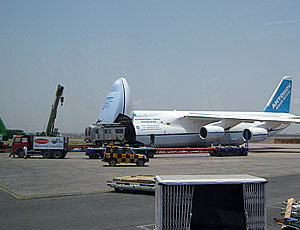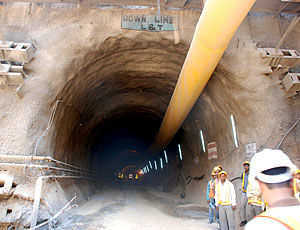The Delhi Metro Rail Corporation (DMRC) is close to completing tunneling for its second phase of construction, with less than 2 kilometers left out of 35 km, following the completion of India’s longest tunnel in an urban area built using the New Austrian Tunneling Method (NATM). The 2.85-km-long tunnel is part of the 22.7-km Airport Express Line, which will connect the Delhi city center to the international airport when completed in the summer of 2010.


NATM has been used to build long tunnels in nonurban areas, including the Konkan Railway, but the metro tunnel is the longest so far in an Indian city. Construction of the tunnels, at a depth of 17 to 27 meters, began in late 2007 with the sinking of three access shafts.
The second phase of the Delhi Metro totals 125 km of new track, of which 35 km is underground. DMRC used 14 tunnel-boring machines, which have so far conducted 30 tunneling drives, besides NATM and cut-and-cover technique for the underground construction, says DMRC. Only five drives to complete about 1.3 km by TBMs now remain in Phase 2.
The NATM work was executed by Hindustan Construction Co. in joint venture with Alpine Mayreder of Austria. It won the $32-million NATM contract calling for a finished internal diameter of a minimum of 10 meters for twin-track railway, including an access and ventilation shaft. It also included external and temporary works for a transmission system link.
“The tunneling was extremely challenging as soft soil was encountered in certain sections in between rocky patches,” says a DMRC spokesman. “As this increased the possibility of loose earth caving in, extra precautions were taken and [we had] laborers specially trained for the purpose. A total of 5.2 million man-hours, including 700,000 man-hours of engineers and technical staff, were utilized.”
The contractor completed 180 m of the job using the cut-and-cove method. But that technique could not be used in the rest of the alignment because the route passes through a protected forest area.
Earlier, HCC in joint venture with Alpine Mayreder and Samsung Corp. received a contract worth $172 million for another section on the same line. Mott MacDonald’s Indian operation was appointed to provide detailed structural and civil designs, including underground station boxes with three-story-deep reinforced-concrete diaphragm walls, twin bored tunnels and cut-and-cover tunnels.
“The challenge will be alignment where the rail level is around 44 m below ground level and crosses underneath the existing Connaught Place Station, which also crosses the north-south and east-west corridors designed by Mott MacDonald in the first phase of the metro development,” says Ashit Shah, Mott MacDonald’s project manager.



Post a comment to this article
Report Abusive Comment